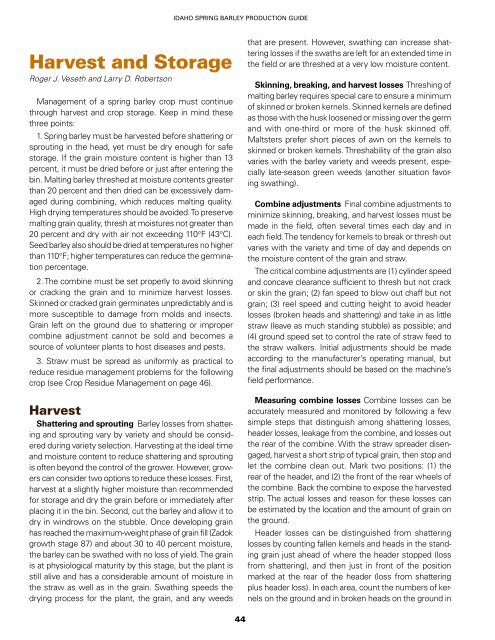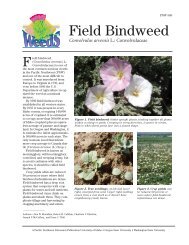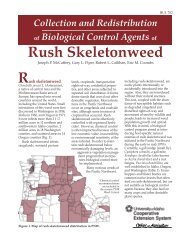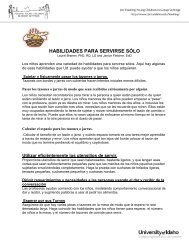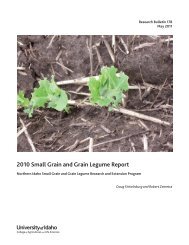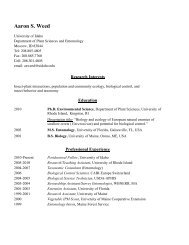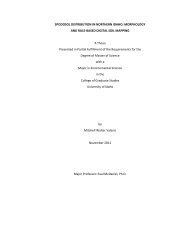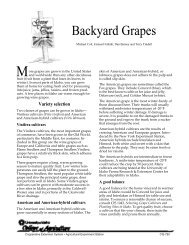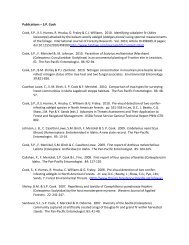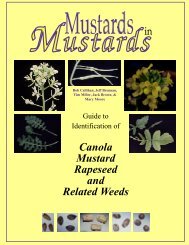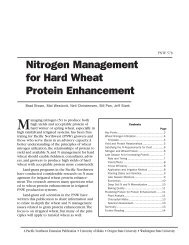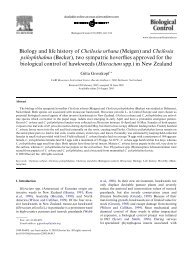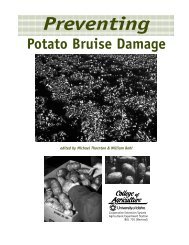Spring Barley Production Guide - College of Agricultural and Life ...
Spring Barley Production Guide - College of Agricultural and Life ...
Spring Barley Production Guide - College of Agricultural and Life ...
Create successful ePaper yourself
Turn your PDF publications into a flip-book with our unique Google optimized e-Paper software.
Harvest <strong>and</strong> Storage<br />
Roger J. Veseth <strong>and</strong> Larry D. Robertson<br />
Management <strong>of</strong> a spring barley crop must continue<br />
through harvest <strong>and</strong> crop storage. Keep in mind these<br />
three points:<br />
1. <strong>Spring</strong> barley must be harvested before shattering or<br />
sprouting in the head, yet must be dry enough for safe<br />
storage. If the grain moisture content is higher than 13<br />
percent, it must be dried before or just after entering the<br />
bin. Malting barley threshed at moisture contents greater<br />
than 20 percent <strong>and</strong> then dried can be excessively damaged<br />
during combining, which reduces malting quality.<br />
High drying temperatures should be avoided. To preserve<br />
malting grain quality, thresh at moistures not greater than<br />
20 percent <strong>and</strong> dry with air not exceeding 110°F (43°C).<br />
Seed barley also should be dried at temperatures no higher<br />
than 110°F; higher temperatures can reduce the germination<br />
percentage.<br />
2. The combine must be set properly to avoid skinning<br />
or cracking the grain <strong>and</strong> to minimize harvest losses.<br />
Skinned or cracked grain germinates unpredictably <strong>and</strong> is<br />
more susceptible to damage from molds <strong>and</strong> insects.<br />
Grain left on the ground due to shattering or improper<br />
combine adjustment cannot be sold <strong>and</strong> becomes a<br />
source <strong>of</strong> volunteer plants to host diseases <strong>and</strong> pests.<br />
3. Straw must be spread as uniformly as practical to<br />
reduce residue management problems for the following<br />
crop (see Crop Residue Management on page 46).<br />
Harvest<br />
Shattering <strong>and</strong> sprouting <strong>Barley</strong> losses from shattering<br />
<strong>and</strong> sprouting vary by variety <strong>and</strong> should be considered<br />
during variety selection. Harvesting at the ideal time<br />
<strong>and</strong> moisture content to reduce shattering <strong>and</strong> sprouting<br />
is <strong>of</strong>ten beyond the control <strong>of</strong> the grower. However, growers<br />
can consider two options to reduce these losses. First,<br />
harvest at a slightly higher moisture than recommended<br />
for storage <strong>and</strong> dry the grain before or immediately after<br />
placing it in the bin. Second, cut the barley <strong>and</strong> allow it to<br />
dry in windrows on the stubble. Once developing grain<br />
has reached the maximum-weight phase <strong>of</strong> grain fill (Zadok<br />
growth stage 87) <strong>and</strong> about 30 to 40 percent moisture,<br />
the barley can be swathed with no loss <strong>of</strong> yield. The grain<br />
is at physiological maturity by this stage, but the plant is<br />
still alive <strong>and</strong> has a considerable amount <strong>of</strong> moisture in<br />
the straw as well as in the grain. Swathing speeds the<br />
drying process for the plant, the grain, <strong>and</strong> any weeds<br />
IDAHO SPRING BARLEY PRODUCTION GUIDE<br />
44<br />
that are present. However, swathing can increase shattering<br />
losses if the swaths are left for an extended time in<br />
the field or are threshed at a very low moisture content.<br />
Skinning, breaking, <strong>and</strong> harvest losses Threshing <strong>of</strong><br />
malting barley requires special care to ensure a minimum<br />
<strong>of</strong> skinned or broken kernels. Skinned kernels are defined<br />
as those with the husk loosened or missing over the germ<br />
<strong>and</strong> with one-third or more <strong>of</strong> the husk skinned <strong>of</strong>f.<br />
Maltsters prefer short pieces <strong>of</strong> awn on the kernels to<br />
skinned or broken kernels. Threshability <strong>of</strong> the grain also<br />
varies with the barley variety <strong>and</strong> weeds present, especially<br />
late-season green weeds (another situation favoring<br />
swathing).<br />
Combine adjustments Final combine adjustments to<br />
minimize skinning, breaking, <strong>and</strong> harvest losses must be<br />
made in the field, <strong>of</strong>ten several times each day <strong>and</strong> in<br />
each field. The tendency for kernels to break or thresh out<br />
varies with the variety <strong>and</strong> time <strong>of</strong> day <strong>and</strong> depends on<br />
the moisture content <strong>of</strong> the grain <strong>and</strong> straw.<br />
The critical combine adjustments are (1) cylinder speed<br />
<strong>and</strong> concave clearance sufficient to thresh but not crack<br />
or skin the grain; (2) fan speed to blow out chaff but not<br />
grain; (3) reel speed <strong>and</strong> cutting height to avoid header<br />
losses (broken heads <strong>and</strong> shattering) <strong>and</strong> take in as little<br />
straw (leave as much st<strong>and</strong>ing stubble) as possible; <strong>and</strong><br />
(4) ground speed set to control the rate <strong>of</strong> straw feed to<br />
the straw walkers. Initial adjustments should be made<br />
according to the manufacturer’s operating manual, but<br />
the final adjustments should be based on the machine’s<br />
field performance.<br />
Measuring combine losses Combine losses can be<br />
accurately measured <strong>and</strong> monitored by following a few<br />
simple steps that distinguish among shattering losses,<br />
header losses, leakage from the combine, <strong>and</strong> losses out<br />
the rear <strong>of</strong> the combine. With the straw spreader disengaged,<br />
harvest a short strip <strong>of</strong> typical grain, then stop <strong>and</strong><br />
let the combine clean out. Mark two positions: (1) the<br />
rear <strong>of</strong> the header, <strong>and</strong> (2) the front <strong>of</strong> the rear wheels <strong>of</strong><br />
the combine. Back the combine to expose the harvested<br />
strip. The actual losses <strong>and</strong> reason for these losses can<br />
be estimated by the location <strong>and</strong> the amount <strong>of</strong> grain on<br />
the ground.<br />
Header losses can be distinguished from shattering<br />
losses by counting fallen kernels <strong>and</strong> heads in the st<strong>and</strong>ing<br />
grain just ahead <strong>of</strong> where the header stopped (loss<br />
from shattering), <strong>and</strong> then just in front <strong>of</strong> the position<br />
marked at the rear <strong>of</strong> the header (loss from shattering<br />
plus header loss). In each area, count the numbers <strong>of</strong> kernels<br />
on the ground <strong>and</strong> in broken heads on the ground in


